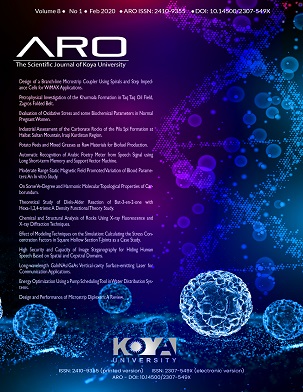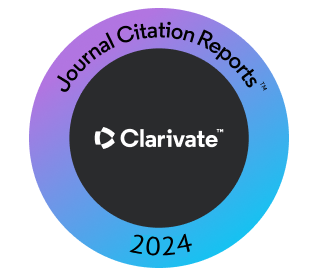Industrial Assessment of the Carbonate Rocks of the Pila Spi Formation at Haibat Sultan Mountain, Iraqi Kurdistan Region
DOI:
https://doi.org/10.14500/aro.10546Keywords:
Pila Spi Formation, Industrial assessment, Cement and Paper industries, Quarrying conditions.Abstract
The Pila Spi Formation is one of the prominent formations forming continuous ridges in Kurdistan Region. The thickness of the formation ranges from 15 to 110 m, consisting of well-bedded limestone, dolomite, dolomitic limestone, and very rare marl beds. The study area is located about 15 km east of Koya town, next to the abandoned tunnel through a deeply cut valley which has exposed 50 m of the formation. However, the uppermost part of the exposed section may belong to one of the Oligocene formations of Kirkuk Group. The study area was selected within the Pila Spi Formation because the rocks of the same formation and along the same ridge, about 45 km west of the study area showed encouraging results for cement industry. The average CaO is about 51%, whereas the average MgO is 1.8%. Therefore, eight samples were collected at constant thickness from the exposed section. The samples were subjected to X-ray fluorescence (XRF) test to indicate the main oxides in the sampled section. The acquired results from the XRF tests showed that the chemical composition of the exposed rocks within the Pila Spi Formation is suitable for cement industry, also for paper and paint but needs some treatment. Accordingly, another eight samples were collected from the same section to increase the density of sampling, totaling to 16 samples.
Downloads
References
Al-Bassam, K. and Al-Khafaj, A.A., 2011. Work Procedures of Iraq Geological Survey, Part 13: Mineral Exploration. Iraq Geological Survey Library Report, No. 2133.
Al-Murib, S., 1980. Report on Prospecting Works on Limestone for Cement Industry in Southern Qara Chouq Mountain. Iraq Geological Survey Library Report, No. 1057.
Al-Rufaie, A. and Muhamad, S., 1976. Report on the Geological Prospecting of Limestone Deposit Suitable for Cement Purpose at Qara Choug Mountain, Khoshao Locality, Arbil. Iraq Geological Survey Library Report, No. 1786.
Al-Rufaie, I., 1976. Investigation of Limestone Suitable for Cement Industry in Qara Chauq Mountain, Khoshao Area. Iraq Geological Survey Library Report, No. 1379.
Etabi, W. and Ahmed, S., 1979. Final Report on Prospecting Exploration of Tasluja Limestone Deposit Suitable for Portland Cement. Iraq Geological Survey Library Report, No. 961.
Fouad, S.F., 2012. Tectonic Map of Iraq, Scale 1: 1000000. 3rd ed. Iraq Geological Survey Publications, Baghdad, Iraq.
Hafidh, S.Q. and Hassan, A.A., 2008. Exploration of Limestone Suitable for Cement Industry in Categories C1 and B at Sartak South of Derbendikhan. Iraq Geological Survey Library Report, No. 3125.
Hafidh, S.Q. and Khlaif, H.O., 2007. Mineral Exploration and Reserve Estimation in Category C1 of the Carbonate Rocks Suitable for Cement Manufacturing at Tasluja, Sulaimaniyah on the Behalf of Sarchinar Cement Plant. Iraq Geological Survey Library Report No. 3038.
Hafidh, S.Q. Ruhman, A., Al-Abaas, F.A., Rasheed, A.Y. and Qanbar, A.S., 2008a. Preliminary Geological Studies of Limestone Suitable for Cement
Industry in Sartak and Kani Kel Vicinity Southeast of Darbandi Khan Southeast of Sulaimaniyah Governorate. Iraq Geological Survey Library Report, No. 3125.
Hafidh, S.Q., Al-Jiburi, B.S. and Basheer, W.P., 2011. Detailed Geological Survey at Scale of 1:5000 in Southern Qara Chauq Mountain, Block/A, for Investigation of Limestone Suitable for Cement Industry in Behalf of Kar Company. Iraq Geological Survey Library Report, No. 3400.
Hafidh, S.Q., Salih, H.A. and Abbas, A.K.A., 2008c. Preliminary Geological Studies on Limestone Suitable for Cement Industry, West of Suliamaniyah on the Behalf of Washa Co. Iraq Geological Survey Library Report, No. 3127.
Hafidh, S.Q., Salih, H.A. and Mahmoud, A.A., 2008b. Preliminary Studies on Limestone Suitable for Cement Industry. Agh Jallar Vicinity on the Behalf of Mawlawi Co. Iraq Geological Survey Library Report, No. 3128.
Jaber, F.S. and Al-Ubaidi, H., 1973. Kani China Recrystalline Limestone. Iraq Geological Survey Library Report, No. 524.
Mansour, J. and Petranek, J., 1980. Major Occurrences and Deposits of Limestone in Iraq. Iraq Geological Survey Library Report, No. 1073.
Mansour, J., 1976. Reconnaissance of the Kirkuk, Erbil, Sulaimaniyah Area on Search for Raw Materials in Connection with Proposed Cement Works. Iraq Geological Survey Library Report, No. 768.
Mansour, J., 1977. Preliminary Examination of the Raw Materials for Al-Tamim Cement Project. Iraq Geological Survey Library Report No. 840.
McGregor, D., 1963. High-Calcium Limestone and Dolomite in Indiana. 27th ed. Indiana Department of Conservation, State of Indiana, p.1-12.
Moorkah, H. and Abolarin, M., 2005. Investigation of the properties of locally available dolomite for refractory applications. Nigerian Journal of Technology, 24(1), p.79-81.
Sissakian, V.K. and Al-Jiburi, B.M., 2014. Stratigraphy of the High Folded Zone. Iraqi Bulletin of Geology and Mining, 6, p.73-16.
Sissakian, V.K. and Fouad, S.F., 2012. Geological Map of Iraq, Scale 1: 1000000. 4th ed. Iraq Geological Survey Publications, Baghdad, Iraq.
Sissakian, V.K. and Fouad, S.F., 2014. Geological Map of Erbil and Mahabad Quadrangles, Scale 1: 250000. 2nd ed. Iraq Geological Survey Publications, Baghdad, Iraq.
Sissakian, V.K. and Saeed, Z.B., 2012. Lithological map of Iraq compiled using GIS Techniques. Iraqi Bulletin of Geology and Mining, 8(3), p.1-13.
Sissakian, V.K., Hamoudi, D.A., Omer, H.O. and Niazi, S.A., 2019. Assessment of the carbonate rocks of the Pila Spi formation for cement industry, in Permam mountain, Erbil, Iraqi Kurdistan Region. UKH Journal of Science and Engineering, 3(1), pp.1-9.
Downloads
Published
How to Cite
Issue
Section
License
Authors who choose to publish their work with Aro agree to the following terms:
-
Authors retain the copyright to their work and grant the journal the right of first publication. The work is simultaneously licensed under a Creative Commons Attribution License [CC BY-NC-SA 4.0]. This license allows others to share the work with an acknowledgement of the work's authorship and initial publication in this journal.
-
Authors have the freedom to enter into separate agreements for the non-exclusive distribution of the journal's published version of the work. This includes options such as posting it to an institutional repository or publishing it in a book, as long as proper acknowledgement is given to its initial publication in this journal.
-
Authors are encouraged to share and post their work online, including in institutional repositories or on their personal websites, both prior to and during the submission process. This practice can lead to productive exchanges and increase the visibility and citation of the published work.
By agreeing to these terms, authors acknowledge the importance of open access and the benefits it brings to the scholarly community.
Accepted 2020-02-18
Published 2020-03-15
















 ARO Journal is a scientific, peer-reviewed, periodical, and diamond OAJ that has no APC or ASC.
ARO Journal is a scientific, peer-reviewed, periodical, and diamond OAJ that has no APC or ASC.